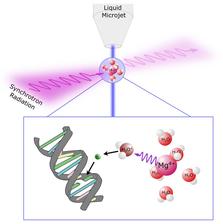Visualisation of the experiment (Credit: Univ. Kassel)
A new study sheds light on how X-rays cause damage in liquids. The results could help to make radiotherapy or X-ray examinations safer in the long term. An international group of scientists from the University of Kassel, the Fritz Haber Institute (FHI) in Berlin, the University of Heidelberg as well as the Uppsala University (Sweden) worked together and carried out their experiments at the PETRA III beamline P04 and at BESSY II in Berlin.
For their study, the scientists exposed a magnesium salt solution to X-rays. Magnesium salt is frequently found in the human body, for example, in nerve cords and in certain DNA proteins. As the research group describes in a recently published paper, they used it to trigger cyclically occurring radiation damage.
X-rays, such as those used in medical X-rays or radiotherapy, contain radiation with a short wavelength and high energy, in contrast to infrared and visible light, for example, which have a long wavelength and low energy. "The radiation sets a cycle in motion," explains Dana Bloß, a doctoral student at the Institute of Physics at the University of Kassel. In the magnesium salt solution, the irradiation produces water radicals and electrons with low energies; the latter are known for their mutagenic effect, for example, by causing radiation damage such as double-strand breaks in DNA.
What is special about the investigated cycle is that the dissolved magnesium ions, despite their initial excitation, fall back into their original state after the production of the aforementioned particles. This allows the process to start again. The damaging release of electrons is repeated in a locally concentrated area of the tissue, just like hammering on the same spot over and over again.
This opens up a new perspective in understanding radiation damage. "This is basic research," emphasizes Bloß. "But we want to understand the processes, and the results are quite surprising. The better we understand these processes, the better other, more application-oriented research groups will be able to improve the devices used in X-rays and radiation therapy, for example."
(partly from News University of Kassel)
Reference:
D. Bloß et al., "X-ray radiation damage cycle of solvated inorganic ions", Nature Communications (2024), DOI 10.1038/s41467-024-48687-2







